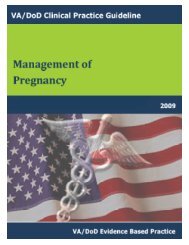DM Full Guideline (2010) - VA/DoD Clinical Practice Guidelines Home
DM Full Guideline (2010) - VA/DoD Clinical Practice Guidelines Home
DM Full Guideline (2010) - VA/DoD Clinical Practice Guidelines Home
You also want an ePaper? Increase the reach of your titles
YUMPU automatically turns print PDFs into web optimized ePapers that Google loves.
Version 4.0<br />
<strong>VA</strong>/<strong>DoD</strong> <strong>Clinical</strong> <strong>Practice</strong> <strong>Guideline</strong><br />
for the Management of Diabetes Mellitus<br />
performed by others that described explicit criteria for deciding what evidence was selected and how it was<br />
determined to be valid. The sources that have already undergone rigorous critical appraisal include Cochrane<br />
Reviews, Best Evidence, Technology Assessment, and EPC reports.<br />
The search continued using well-known and widely available databases that were appropriate for the clinical subject.<br />
In addition to Medline/PubMed, the following databases were searched: Database of Abstracts of Reviews of<br />
Effectiveness (DARE) and Cochrane Central Register of Controlled Trials (CCTR). For Medline/PubMed, limits<br />
were set for language (English), date of publication (2002 through May 2009) and type of research (RCT and metaanalysis).<br />
For the CCTR, limits were set for date of publication (2002 through 2009).<br />
Once definitive reviews or clinical studies that provided valid relevant answers to the question were identified, the<br />
search ended. The search was extended to studies/reports of lower quality (observational studies) only if there were<br />
no high quality studies.<br />
Exclusion criteria included reviews that omitted clinical course or treatment. Some retrieved studies were rejected<br />
on the basis of published abstracts, and a few were rejected after the researchers scanned the retrieved citation for<br />
inclusion criteria. Typical exclusions included studies with physiological endpoints or studies of populations that<br />
were not comparable to the population of interest (e.g., studies of diabetes in children or pregnancy).<br />
The results of the search were organized and reported using reference manager software. At this point, additional<br />
exclusion criteria were applied. The bibliographies of the retrieved articles were hand-searched for articles that may<br />
have been missed by the computer search. Additional experts were consulted for articles that may also have been<br />
missed.<br />
The literature search for the guideline update was validated by: (1) comparing the results to a search conducted by<br />
the independent research and appraisal team; (2) a review of the database by the expert panel; and (3) requesting<br />
articles pertaining to special topics from the experts in the working group.<br />
Preparation of Evidence Tables<br />
The results of the searches were organized in evidence reports, and copies of the original studies were provided to<br />
the WG for further analysis. Each reference was appraised for scientific merit, clinical relevance, and applicability<br />
to the populations served by the <strong>VA</strong> and <strong>DoD</strong> healthcare systems.<br />
The clinical experts and other researchers in healthcare independently read and coded each article that met inclusion<br />
criteria. Each article was turned into a one-page summary of the critical appraisal by the research team and added to<br />
a central electronic database.. Each of the evidence reports covered:<br />
• Summary of findings<br />
• Methodology<br />
• Search terms<br />
• Resources searched<br />
• Summary table of findings<br />
• Critical appraisal of each study<br />
The quality rating procedure used in this update was different from the rating scale used in the development of the<br />
original guideline in 1999. Where adjustments to the update process were made, articles from the original process<br />
were re-graded to reflect the changed rating scale (e.g., the strength of recommendation [SR] was assigned for each<br />
recommendation, based on study design and significance of the quality of the evidence).<br />
Evidence-based practice involves integrating clinical expertise with the best available clinical evidence derived from<br />
systematic research. The Working Group reviewed the evidence and graded it using the rating scheme developed by<br />
the USPSTF (2007). The experts themselves, after an orientation and tutorial on the evidence grading process,<br />
formulated Quality of Evidence ratings (see Table 1), a rating of Overall Quality (see Table 2), a rating of the Net<br />
Effect of the Intervention (see Table 3), and an overall Recommendation (see Table 4).<br />
Appendices Page 123
















